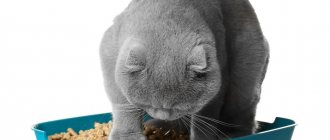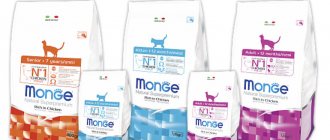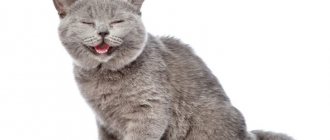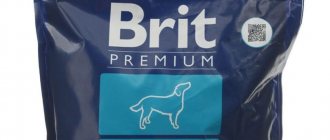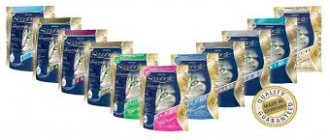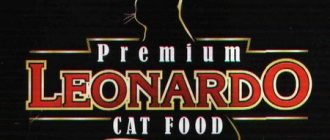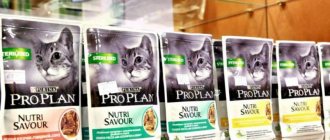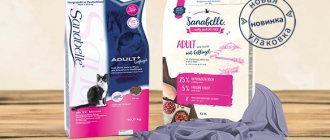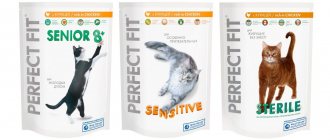September 7, 2018
A balanced diet is especially important for kittens; it is at this age that the animal actively grows and develops. High-quality dry food is just such a product, which means it may well become the first “adult” diet for babies, which is introduced even before the end of breastfeeding. Let's figure out at what age kittens are given dry food.
How to arouse interest in dry food in a kitten?
Sometimes kittens have difficulty when first introduced to dry food, even despite the small size of the granules, because teeth grow gradually. Sometimes the kitten doesn’t even understand what these strange “things” are, and even mistakes the dry granules for funny balls and starts playing with them. In this case, you can experiment: try giving the kittens dry food, previously soaked in warm water.
Wet food has a stronger smell, and the soft texture will be more comfortable for a kitten who has not yet acquired a full set of baby teeth. Once your kitten gets used to the soaked food, start adding dry kibble to it, starting with a small amount and gradually reducing the amount of soaked food.
This method usually works well because the kitten is already accustomed to the taste and smell of dry food. A complete transition to dry food is recommended no earlier than 2–3 months of age, after the kitten has been weaned from its mother cat.
Complementary feeding rules
Developing the habit of proper nutrition in kittens requires a great deal of responsibility.
When providing complementary feeding, it is important to follow some recommendations:
- Every day you need to introduce one new product into the diet so that you can monitor how your pet’s body reacts to different foods.
- If the proposed product is not suitable for some reason, it is excluded from the diet.
- It is forbidden to give minced meat to animals, as it is poorly digestible.
- Beef should be offered initially; once kittens learn to chew food, they will be able to eat chicken pieces.
- Accustoming to dry food should be done gradually; it is advisable to dilute it with water at first.
- Special vitamins are produced for kittens, depending on their age. They can be used too.
© shutterstock
Rules for feeding a kitten dry food
In order for a kitten to grow strong and healthy, dry food must be of high quality, that is, it must consist mainly of meat ingredients and contain all the necessary substances. Kittens also need additional components that will help their body cope with growing difficulties.
Thus, Blitz Kitten dry food, in addition to important micro and macronutrients, also contains live probiotics to support the kitten’s immune system, as well as fennel extract, which helps reduce gas formation and prevents intestinal discomfort in the kitten.
Follow the daily allowance - it is indicated on the back of the food package. Remember that this is the amount of feed required per day, not per feeding. You can divide the specified volume into several feedings, for example, morning and evening, and the baby will come to the bowl as many times a day as he needs. The exception is severely hungry, street kittens. They may try to eat all the food offered at once, so at first you will have to give them food little by little and often.
Make sure your pet drinks plenty - access to fresh water should be available around the clock. Cats naturally drink little, and eating dry food requires a lot of water, so try to make sure that the kitten does not get thirsty.
During the transfer period, pay attention to the condition of the kitten - the skin and mucous membranes should be clean, the stool should be properly formed. If you experience diarrhea, constipation, itching or redness, consult your veterinarian.
Switching to adult food
A young body grows and gets stronger quickly, it needs a set of nutrients and vitamins. Kittens begin complementary feeding at three to four weeks of age. Before introducing complementary foods into the menu of small pets, you need to check whether they are feeling well and healthy.
© shutterstock
When starting complementary feeding, it is important to consider the age of the babies. Many people are concerned about how the owner can understand that it’s time to diversify the kittens’ diet. If the animal was picked up on the street, then its age can be determined by a veterinarian. When the mother is a domestic cat, then there will be no problems with counting the number of days and weeks.
At what age do kittens born from their cat begin to feed complementary foods? Usually, the mother feeds the newborns for the first 3-4 weeks, and after this period, she herself will bring her babies to the bowl and ask the owner to feed them additionally. There are times when a cat is not able to feed the babies, then the owner must take on this role.
How to properly organize complementary feeding, what food kittens need depending on their age:
- less than a month - it is allowed to give only warm boiled milk for complementary feeding;
- 4-8 weeks - it is worth adding more viscous food to the menu, which has the consistency of porridge;
- more than two months - a painless transition to adult food is possible; complementary feeding can be organized using meat, vegetables and ready-made food from the store.
At the age of one month, kittens should be given the opportunity to drink fresh water. It is better to place it a little away from the place where pets eat. It is advisable not to use a plastic bowl; it should be made of metal, glass or porcelain. Some housewives place several bowls at once in different places. You can build a special drinking fountain.
Features of the diet for kittens
In order to easily digest and absorb food, kittens must have a healthy digestive system, which is so easy to “break” at a young age. In addition, the physiological needs for feed ingredients for young and adult animals are significantly different. The following information will help you create the right diet for small pets:
- The energy requirement of a kitten at the age of 1-2 months exceeds the energy expenditure of an adult animal by 3-4 times (in terms of 1 kg of body weight), which is explained by enhanced metabolic processes. That is why the diet of babies should be high-calorie and easily digestible.
- Cats are carnivores, which means their diet should be based on high-quality protein found in animal products. Feed protein is necessary for building the body’s own tissues, so protein poverty in the diet leads to growth retardation, disruptions in the immune system, and impaired liver and kidney function. The optimal protein requirement for babies is at least 10 g per 1 kg of body weight, compared to the norm of 6.3 g per 1 kg of body weight for adult cats. Thus, growing kittens should receive 1.5 times more protein in their food than mature animals.
- The most important nutritious protein product for small kittens is milk. In their digestive tract, under the influence of the lactase enzyme, lactose (milk sugar) is digested, while in adult animals this enzyme is absent and drinking milk can result in intestinal upset.
- Vitamins are biologically active substances that trigger the most important life processes, which is why vitamin deficiencies have such a detrimental effect on the growth and development of the younger cat generation. The needs of kittens for vitamins of various groups are on average 50% higher than those of adult cats (calculated per 1 kg of body weight).
- Minerals are necessary, first of all, for the construction of a growing skeleton and the formation of teeth. In addition, macro- and microelements are necessary for the regulation of metabolism and the normal functioning of all organs and systems. Young cats, in comparison with adults, need an increased supply of minerals from food, and this difference is twofold for calcium, magnesium and phosphorus.
- By the age of 2 months, a kitten’s baby teeth are formed, so all food in early childhood should be served in liquid and warm form. In addition, crushed food is much easier to digest for a delicate stomach and is absorbed by the intestines with unsettled microflora.
- The transition from puree to solid food should be step-by-step with a gradual reduction in the amount of water. By learning to use its jaws and chew, the kitten will be able to chew on pieces of food, while the active enzymes of a stronger digestive system will digest rougher food.
A small kitten may well taste food from its mother’s bowl and this will not cause him much harm.
However, the long-term nutritional program for cubs must be special.
What to feed newborn kittens without a cat?
The best option is a cat milk replacer. If for some reason this is not possible, you can prepare a mixture similar in composition to cat milk according to the following recipes:
- Baby formulas. Milk is prepared twice as liquid as for a baby in the first week of life.
- For 100 ml of cow's milk add one chicken yolk, 7 ml of 5% glucose and 3 drops of tetravit.
- Dilute 5 ml of cream 10% fat with boiled water in a volume of 3 ml and add 2 ml of 5% glucose.
- Goat milk mixed with water.
How and where to start complementary feeding?
The cat's main diet is meat and fish. It is advisable to start complementary feeding with raw beef. Before feeding, the meat is frozen at t - 18-20 ° C for a week. Divided into portions for convenience. Kittens need to be given meat daily. When animals learn to chew, rabbit, poultry, and horse meat are introduced. Porridge and low-fat fresh cottage cheese can be given to children every day to provide the body with calcium and carbohydrates. The quantitative ratio is a third of meat. Semolina, oatmeal, buckwheat, and rice cereals are suitable, without adding salt or sugar during cooking. The basis of porridge is milk.
The baby can try boiled liver as early as 8 weeks.
By the age of 2 months, animals can begin to be fed boiled liver, heart, and lungs. Boiled chicken egg yolk is useful. Quail eggs do not need to be separated from the white, but given whole. The listed products are offered to the kitten no more than once a week. Increase food portions gradually, without changing the frequency of feedings (every 3-4 hours).
3 months is the appropriate age to start introducing boiled sea fish. Give no more than 2 times a month. Hake, cod, capelin, flounder, pollock and other low-fat species with a small amount of bone are acceptable. At this age, the cat is offered finely chopped dill and parsley seasoned with vegetable oil. Vegetables and herbs are included in the daily feeding, but in very small doses.
At 4 months, kittens are completely ready for adult life; they can be fed 2-3 times a day. There is no need to give milk from this age; the body of an adult cat does not absorb this product. Healthy fermented milk products - natural yogurt, kefir, yogurt, low-fat cream. Cheese is too fatty a product, so it is acceptable in a cat’s diet no more than 2 times a month.
Daily feeding of food should be 10% of the small pet’s weight.
How are the feeds different?
A completely reasonable question arises for a cat owner when he begins to compare prices for commercial food. How do feeds differ and what determines their cost? The first and key factor by which cat food differs is quality.
Feed is divided into: economy class, premium, superpremium and holistic.
- Economy class is not suitable for everyday feeding of cats; it contains many preservatives and is made from cheap raw materials.
- Premium and super premium feeds are suitable for everyday feeding of healthy animals.
- The super premium lines of some manufacturers include food intended for animals with a sensitive gastrointestinal tract, skin problems and other chronic ailments.
Note! Holistic food is considered the highest quality, which is why their price is so high. This class of food does not have any medicinal or unique properties; the high price is due to the use of high-quality, natural raw materials.
Dry food
Dry food, regardless of class, is made from crushed and dried products. Almost all feeds contain a carbohydrate component, which is fermented at the manufacturing stage. To form granules, the powder mixture is wetted and pressed. Afterwards, the feed goes through a re-drying stage.
The most obvious advantage of dry food is its long shelf life and convenience for the owner. For a cat, food in the form of granules is not entirely natural. In addition, immediately after eating dry food, the cat feels very thirsty.
Semi-moist and wet food
Wet food, contrary to colorful advertising, is produced similarly to dry food. The products are crushed, partially fermented, moistened and formed into pieces. Broths with a thickener are used as gravies and sauces. To make pates, the same ingredients are mixed until smooth.
The obvious disadvantage of wet food is its higher cost. With a similar composition of dry and wet food of the same brand, the first option will cost more. Bags with single servings contain much more water, so their cost (compared to drying) by weight is several times higher.
